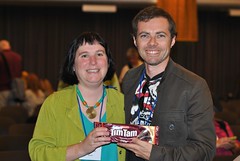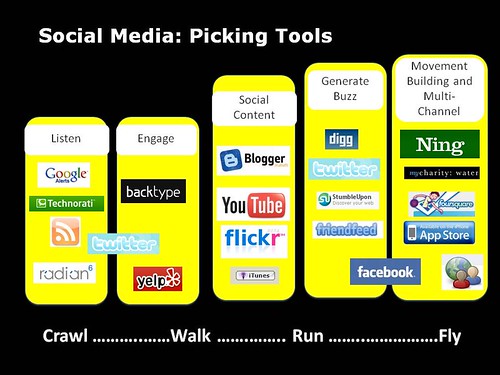I was honored to be the keynote speaker for the Bay Area Microsoft/TechSoup Global Connection Day on Monday. This post summarizes the content I shared in my presentation and offers some reflection on the conversational keynote.
Connecting With Colleagues
TechSoup Global was the co-sponsor and it was great to catch up with long-time colleague, Marnie Webb, Co-Ceo. One of the reasons I made a commitment to blogging about professional topics regularly was because I was inspired by Marnie’s nonprofit technology blog, ext. 337. I was also an early member of Netsquared Community, another one of Marnie’s brilliant ideas that rocked the field. Marnie also introduced me to social booking and tagging way back in 2004 as the originator of the NpTech Tag.
Connecting With New Colleagues

I started my talk with a story about why I liked Twitter: It allows me to connect with people in my professional field and have a great conversations or ad hoc collaborations that improve practice. I used David Hood as an example. He works for an NGO in Australia and we met on Twitter (via Eddie Harran) prior to his visit to America to attend the Wisdom 2.0 Conference . (He even brought me some Tim-Tams.)
David was interested in learning more about what American nonprofits were doing with social media, he asked me for some advice. I invited him to help with the research for the keynote. When possible, I get a list of attendees at workshops or conferences, and I visit their web sites and social media outposts. Not only does this help me frame and tailor the talk I give to the audience, but facilitates Twitter conversations before. Also, I insert screen captures of best practices that I spot and incorporate a dialogue with them in my keynote.
I also had an opportunity to hear Akhtar Badshah, Senior Director of Global Community Affairs at Microsoft Corporation give an overview of their Corporate Citizen Program. The NGO Connection Day is only one small part of their impressive effort which includes these nonprofit technology partners. (I also found out about a new NGO CRM tool from Microsoft)
Conversational Key Note
I don’t like giving a keynote where I talk at the audience for 45 minutes. What fun is that for me or them? I want to engage people in the room to share their experience. So making the audience part of the slide deck and inviting commentary surfaces the wisdom and knowledge in the room. Take for example the SFSPCA Facebook Page, a stellar example of engaging fans that David discovered for me. There was also a wonderful blog, “Litter Did You Know” and the above video about “Lady Meow Meow.” But the real story was when the SFSPCA staff shared during the keynote was that these regular videos are produced by volunteers!
Theory and Practice
The title of my talk was “The Dancefloor and the Balcony: How NGOs Can Excel Using Social Media” The Dance Floor and the Balcony metaphor comes from a book called ‘Leadership Without Easy Answers‘ by Ronald Heifetz. He discusses a way of seeing both the big strategic picture and the smaller immediate tactics. This concept can be applied to effective social media — having social media be both strategic, laddering up to your program or communication goals as well as using the tools effectively.
And of course the word “excel” is short for excellent or To do or be better than; surpass – and it is also the name of one of my favorite social media tools. Excel. One of the sub-themes was to point out opportunities to use excel in your social media work flow.
Effective Social Media
The presentation takes the audience through my Principles for Effective Social Media with examples from the audience and others. Each principle is also illustrated with some practical and tactical advice that ladders up to strategy. The principles cover strategy, learning, capacity, and organizational culture.
My opening framework breaks down the strategy into strategy blocks. These incremental chunks that can be laddered up to program or communications goals. I urge people to think of the chunks and then the tools. The point I make over and over is that you begin slowly with small steps and build up to your capacity level. This is the crawl, walk, run, and fly approach used by NASA and later by Obama. These ideas are illustrated in the slides below.


- 1: Social media must be integrated with internet communications or program strategy.
Examples: Wildlife Direct and Brooklyn Museum
Begin with a communications and program assessment that helps you best determine where social media brings value, the objective, audience, and budget. Use an excel spreadsheet to look at events, fundraisers, programs, web site content, performances, and other activities to socialize.
- 2: Use listening techniques to develop a deep understanding of the audience
Example: Red Cross
Organizations must begin with listening, but an integrated listening channel that includes social media and traditional marketing channels. I cover a couple techniques and tools using participants as an example to illustrate that keywords are king. And, of course, many of the listening tools like Radian 6 or free ones like Social Mention allow you export your listening streams into excel spreadsheets!
- 3: Use conversation starters to engage your target audience.
Examples: San Jose Opera use of #Operaplot Twitter Hashtag
The most important thing for nonprofits is to shift from messaging to conversation starters based on listening. And of course, you can use a spreadsheet to plan out your conversation starters!
- 4: Identify influencers on social media spaces and cultivate them
Example: Northern California ACLU social network analysis of their followers on Twitter.
I introduce a couple of basic social network analysis concepts and how they apply to an organization’s friends, fans, and followers on social media sites. I also mention other tools like Friend or Follow or NodeXL both of which make influencer analysis more efficient with the ability to export the data into an excel spreadsheet.
- 5: Make sure your content has a social life
This point is about making sure you are thinking about your web site content and social media outposts in an integrated content strategy. Also, the way people are consuming content is changing because of social media. We can no longer think of our web sites as the one stop destination to get the whole context. People are more likely to stumble upon content in small chunks via their friends on social networks. This changes how nonprofits need to think about web social content strategy and how to make it efficient.
Here’s where I had a lot of fun pulling up screen shots of participants Web and Social Media outposts.
- 6: Use social media to close the loop between online and offline action
This is about making sure that your social media is integrated into all marketing channels and that you have to think in both directions — from offline to online and online to offline. I give some very specific tips here.
- 7: Allocates enough staff time and has the expertise to implement the strategy
I start with a crawl-walk-run-walk framework for staffing models for nonprofits. I also talk about tracking the time because working on social media can give you ADOLAS (AD – oh look a squirrel!) If you track you time and have specific tasks, you know what you’re getting for your time investment. It’s just one step away from looking at ROI. I had a funny picture of a Squirrel and shouted out Squirrel at random points during the presentation.
- 8: Launch small pilots and reiterates using the right metrics to understand what is and what isn’t working.
I talk about spreadsheet aerobics and other measurement tips. There are many ways to use excel, take for example, my Facebook Analysis excel template. (join my fan page, read the thread, and the link is at the bottom)
- 9: Assesses organizational culture and has strategies to address issues that may prevent adoption
I’ve been writing about technology adoption and culture change for a long time and how it applies to social media. I also offer some pointers around developing a social media policy. This is a big theme in my book, The Networked Nonprofit – so stay tuned.
How is your nonprofit excelling at social media?
Update: Akhtar Badshah wrote this summary of the keynote in the Huffington post
